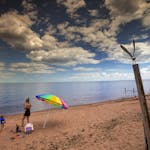State officials are nearing the politically sensitive point of establishing a threshold for how far the water line of a lake or a stream can drop before they step in and limit pumping of groundwater nearby.
The issue is highly charged because, as Jason Moeckel, section chief for the Minnesota Department of Natural Resources (DNR) put it at a meeting Friday, "the reality is, we don't reduce our use of water when things are dry, we increase our use."
Twenty-five groups that could be affected, notably golf courses and farmers who irrigate, have been working on a proposed solution.
A DNR report is due out next month, Moeckel told the gathering at the agency's headquarters in St. Paul that included water experts from the public and private sector in the highly affected northeast metro area who follow the increasingly testy issue.
A draft of the report warns:
"In recent years, it has become increasingly clear that Minnesota's water resources, while still abundant in many areas, are not unlimited. Water supplies are at risk of overuse in some locations, and poor water quality limits access in others."
The poster child for the problem is White Bear Lake, where levels have dropped dramatically in recent years, leading to intense battles over who's at fault and what should be done to fix it.
Indeed, questions on Friday came first from Jane Harper, of the White Bear Lake Conservation District, and Jim Markoe, of the White Bear Lake Homeowners Association, who asked whether climate change needs to be factored in.
Moeckel's answer: "We have to consider it, but how? We don't know yet."
The core question for state regulators is: How much a lake or stream can drop before it hurts fish and plant life, recreational use by boaters and others, and the like. The answer may not be uniform across the state, Moeckel said.
"Wild rice lakes are really sensitive to water levels," he told the group. "But boaters, too: boats can hit bottom and be unable to get from one bay to the next. It's challenging to think of numeric thresholds across the state."
Water bodies naturally rise and fall, hydrologists say, so how bad does it have to get before the state can intervene? Ten percent drops might be fine, but 20 percent might be a crisis, Moeckel said.
"We're trying to find the right language to capture what most people understand we want," he added. "We want to keep water resources; we need our economy to function well. How do we get there and what does that look like?"
David Peterson • 651-925-5039


